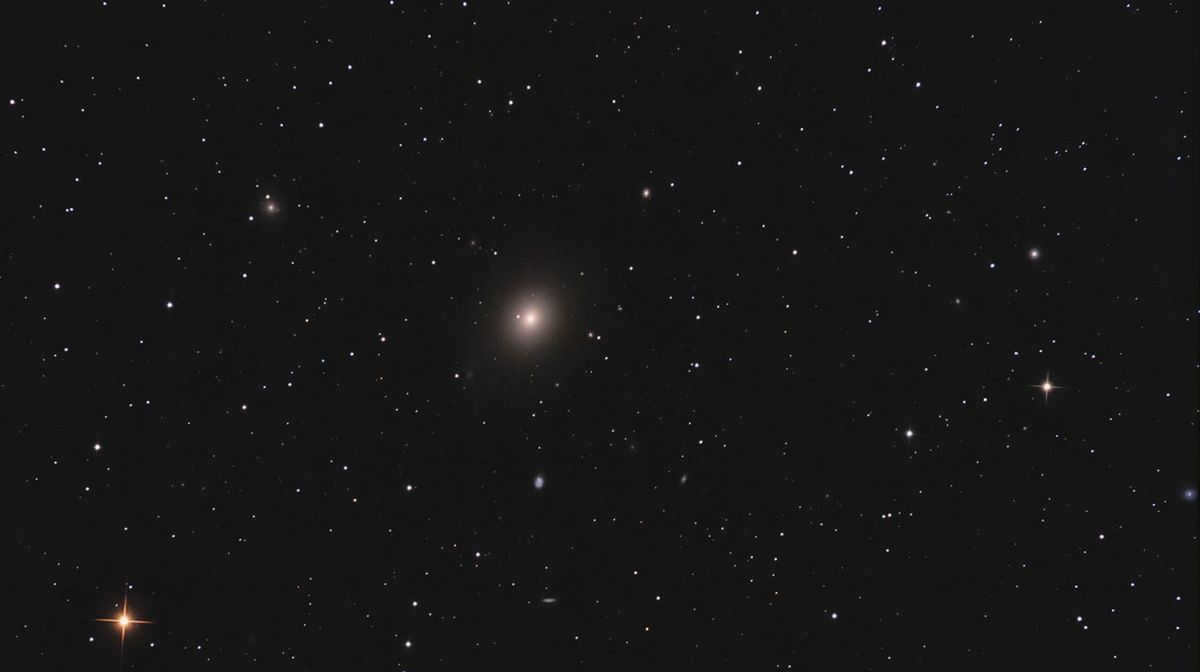
Indeed, the progression of galaxies is the process of their advancement. It is accompanied by alterations in structure and composition.
Let’s explore how galactic modifications transpired.
We can identify three primary stages in the galaxy’s history:
Advancement is an actuality, not a hypothesis
Carl Sagan
The formation of galaxies: a journey from the Big Bang
Now, let us delve into the fascinating realm of the Big Bang theory. It is widely accepted that the birth of galaxies, along with a myriad of other celestial entities, became a reality in the aftermath of this monumental event.
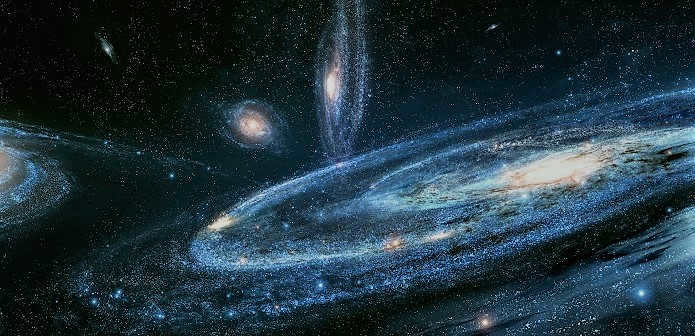
Furthermore, right after the explosion, a singularity materialized. Essentially, in the initial moments, the Universe existed in an infinitely condensed state with an immensely high temperature. Subsequently, the homogeneous medium commenced its expansion while cooling down. As time progressed, regions with higher density gravitationally attracted one another.
An important concept to consider is gravitational instability. This principle asserts that matter particles cannot remain uniformly dispersed throughout space indefinitely. Rather, particles have a tendency to attract each other, resulting in the formation of compacted compounds.
Consequently, gas clouds and clusters of matter took shape. Subsequently, stars were born, ultimately leading to the emergence of entire galaxies.
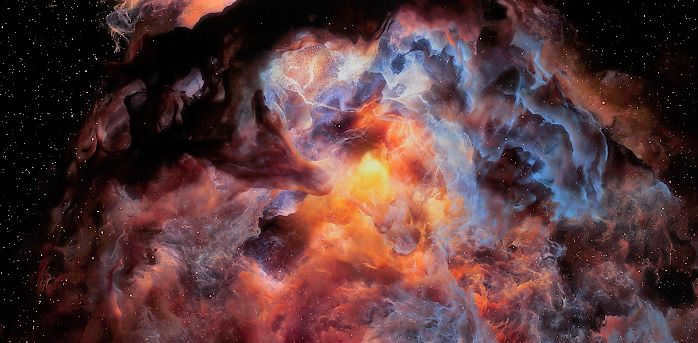
Galaxy formation and evolution
Put simply, the development and merging of galaxies is a process of evolution.
As it is widely known, galaxies are drawn together by the force of gravity, resulting in their fusion. This is how galaxy groups, clusters, and superclusters are formed.
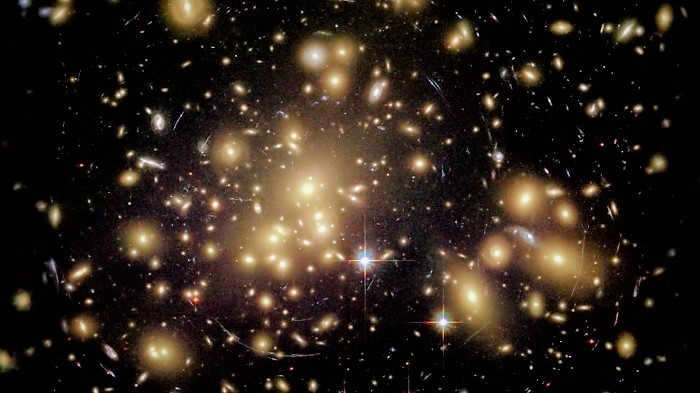
In addition, smaller galaxies are assimilated by larger galaxies, resulting in an increase in mass. Furthermore, galaxies of similar sizes combine to form a unified cluster, ultimately giving rise to colossal elliptical galaxies.
The final phase of galaxy evolution
As the supply of gas and dust diminishes in interstellar space, the formation of new stars comes to a halt. This gradual process spans billions of years. However, the merging of deep space objects continues, resulting in an increase in the abundance of stars, gas, and dust. Consequently, the galaxy system is sustained and expands.
Occasionally, these galaxies are engulfed by other galaxies, granting them a second life, albeit in a different composition.
An intriguing theory suggests that eventually all galaxies will merge into a single colossal elliptical entity.
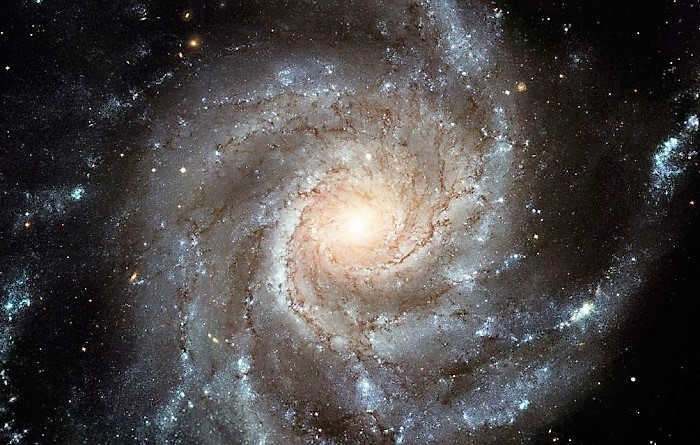
Certainly, the development of galaxies is an incredibly lengthy and intricate process. Envision what existed in the initial stages and what exists presently. It is an entire narrative with no apparent conclusion. At least, not as of now. We can only speculate about what lies ahead for galaxies and the Universe as a unified entity.
The phase of expansion and progression is perpetually captivating and engrossing. It doesn’t matter what we are observing. However, keeping track of the evolution of the Universe is even more enthralling. Particularly because there are always more mysteries surrounding it than solutions.
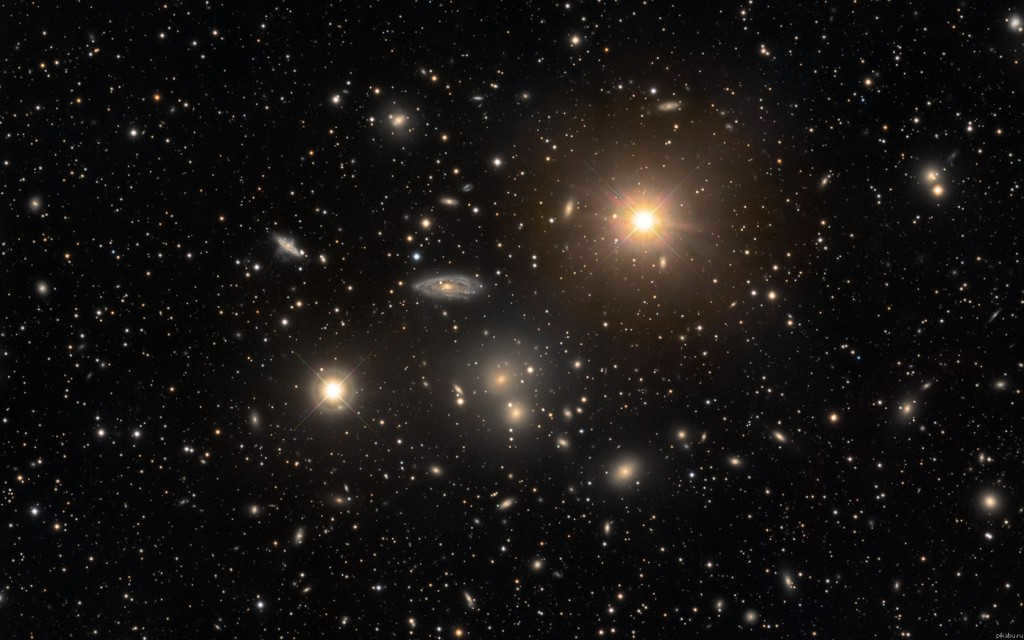
Cosmological research conducted in the last two decades of the previous century revolutionized astronomers’ perception of the Universe and its constituents.
The most significant finding was the validation of the hypothesis that nebulae, previously believed to be mere agglomerations of gases and cosmic debris, are in fact immense collections of stars known as galaxies.
The Formation Theory of Galaxies
The theory explaining the formation of galaxies revolves around the concept of gravitational instability. According to this principle, matter particles cannot remain uniformly distributed throughout space indefinitely. Instead, these particles naturally gravitate towards each other, eventually forming conglomerates.
Galaxies are believed to form through the collision and merger of smaller galaxies.
Gravitational instability in the early Universe led to the formation of disk-shaped matter clusters. These clusters gave rise to swirls and flakes of matter at their edges. Within these protogalactic structures, the process of fragmentation began, resulting in the birth of the first stars. The presence of stars transformed the protogalactic cloud into a galaxy, which can vary in size and shape. Galaxies that formed with a high rate of rotation took on the shape of a ball or a disk with spiral arms extending from it. Proto-galactic clouds that rotated slowly or remained stationary evolved into ellipsoidal or irregularly shaped galaxies.
Other relevant information
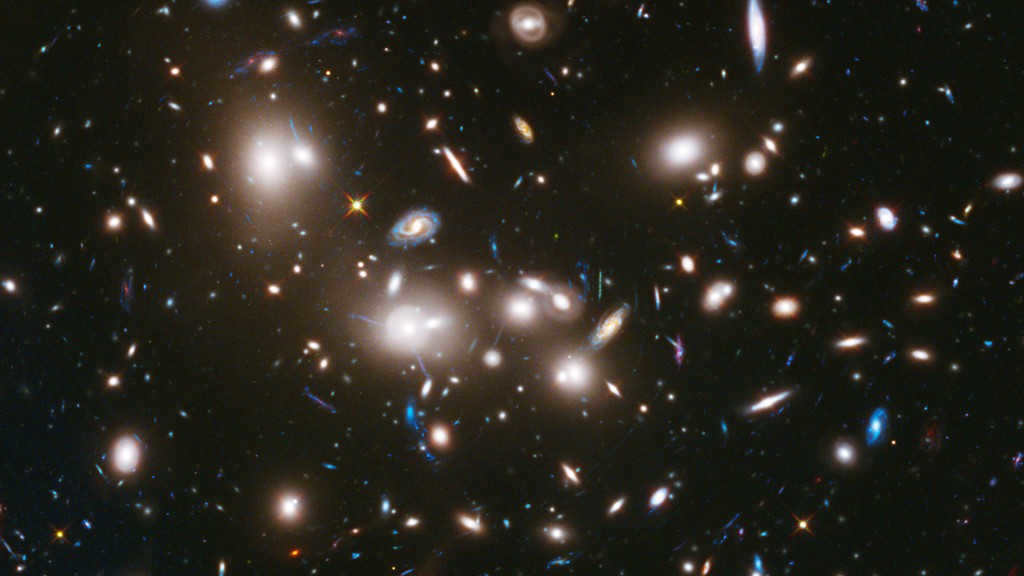
There are various types of galaxies, including single galaxies, pairs of galaxies, and clusters of multiple galaxies. These galactic groups consist of star systems that come in different shapes and sizes. The Big Dipper galaxy cluster and the compact cluster of galaxies in the constellation Veronica’s Hair are our nearest neighbors. Additionally, our Milky Way galaxy, along with the star systems in the Magellanic clouds, the Andromeda galaxy, and many more, make up the Local Group of galaxies. These galaxies are connected by a shared hydrogen cloud.
If you enjoy this post, share it with your friends!
For thousands of years, humans have been studying planets and stars. The Sun, comets, asteroids, and meteorites have been the focus of scientific exploration for centuries. However, it was not until the 1920s that galaxies, which are clusters of stars, cosmic gas, and scattered dust particles throughout the Universe, became the subject of scientific research.
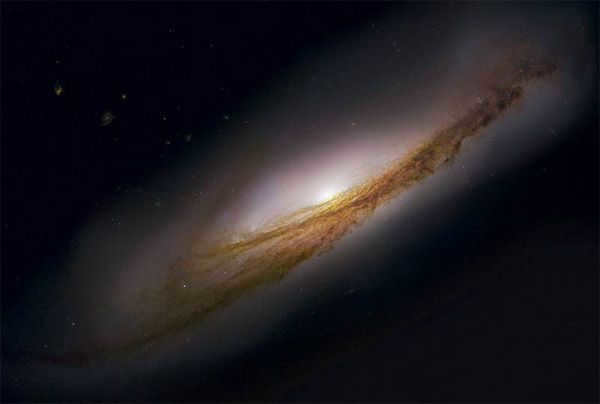
The true nature of these objects remained a mystery for a long time. In the mid-18th century, some astute thinkers posited that they were stellar systems akin to our own Milky Way, but the limitations of telescopes at that time prevented the testing of this hypothesis. A hundred years later, it was widely believed that each nebula was a gas cloud illuminated from within by a young star. However, astronomers were uncertain if these nebulae, including the Andromeda nebula, were located within our own Galaxy or outside of it. It wasn’t until 1923-1924 when Edwin Hubble made the groundbreaking discovery that the distance from Earth to the Andromeda nebula was at least three times the diameter of the Milky Way (in reality, it was about 20 times larger) and that M33, another nebula in Messier’s catalog, was similarly distant. These findings marked the birth of a new field of study known as galactic astronomy.

Dwarfs and giants
The cosmos is teeming with galaxies of varying sizes and masses. The exact number of galaxies is still a rough estimate. Seven years prior, the Hubble space telescope detected approximately 10,000 galaxies in just three and a half months. This observation covered an area of the sky that was a hundred times smaller than the moon’s disk in the southern constellation of Pecha. If we assume that galaxies are uniformly distributed across the celestial sphere, then there would be around 200 billion galaxies in the observable universe. However, this estimate is likely a significant underestimate, as the telescope may have missed a substantial number of extremely faint galaxies.
Within the realm of galaxies, there exist both diminutive dwarfs and colossal giants. According to the esteemed Oxford Handbook’s Companion to Cosmology 2008 edition, the tiniest galaxies house millions of stars, while the largest ones accommodate trillions. However, this knowledge has since become antiquated. Professor John Kormendi from the University of Texas at Austin revealed to “PM” that in recent years, a cluster of miniature galaxies containing only a few hundred stars has been discovered. These are known as ultracompact dwarfs, with linear dimensions spanning 20 parsecs. Despite the limited number of stars, the mass of such galaxies amounts to millions and tens of millions of solar masses. It is highly probable that dark matter plays a significant role, although some scientists argue that black holes and neutron stars contribute significantly as well. Regardless, the traditional definition of a galaxy as a vast independent star cluster is no longer applicable. At the uppermost end of the galactic spectrum, supergiants measuring a megaparsec in diameter and boasting stellar populations in the hundreds of trillions can be found.
Galaxies exhibit variations in their morphology, or shape. Broadly speaking, they can be classified into three major types – disk-shaped, elliptical, and irregular. This is a general categorization, as there are more detailed classifications available.
A disk-shaped galaxy can be visualized as a flat, circular structure that rotates around an axis passing through its central point. Typically, there is a bulge that appears oval-shaped on either side of the central region of the disk (referred to as the bulge). The bulge also rotates, although at a slower rate compared to the disk. Spiral arms are often observed within the disk, hosting numerous young and luminous stars. However, there are disk galaxies that lack a spiral structure, with a scarcity of such bright stars.
The central region of a disk-shaped galaxy can be divided by a stellar bar – a lintel. The inner part of the disk is filled with a gas-dust medium, which serves as the building blocks for new stars and planetary systems. The galaxy consists of two disks: a stellar disk and a gas disk. These are surrounded by the galactic halo, a spherical cloud of hot gas and dark matter that contributes significantly to the total mass of the galaxy. The halo also houses individual old stars and globular star clusters (known as globular clusters) that are up to 13 billion years old. In almost every disk-shaped galaxy, whether it has a bulge or not, there is a supermassive black hole located at its center. The largest galaxies of this kind contain a staggering 500 billion stars each.
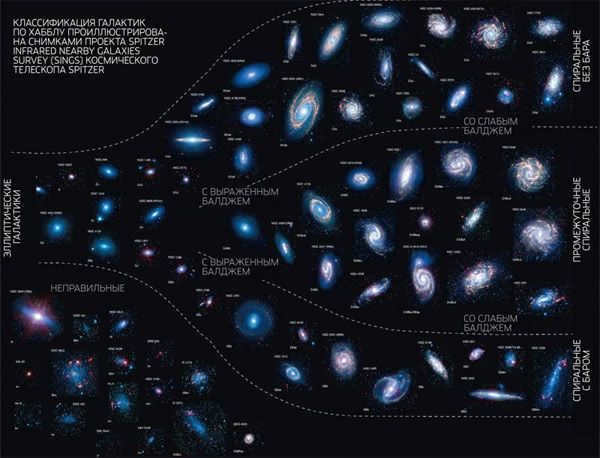
An elliptical galaxy, known for its ellipsoid shape, lacks axial symmetry and does not rotate as a whole. Instead, its stars, which are generally of smaller mass and solid age, orbit the galactic center in various planes, sometimes forming elongated chains. The scarcity of molecular hydrogen, the initial raw material, means that new stars are rarely formed in elliptical galaxies.
Elliptical galaxies encompass both the largest and smallest types in the galactic population, making up only about 20% of the Universe’s galaxies. Most elliptical galaxies, except for the smallest and dimmest, also contain supermassive black holes in their central regions. While elliptical galaxies do have halos, they are not as pronounced as those found in disk-shaped galaxies.
Distribution of Stars
The arrangement of stars in outer space is far from being random. Large galaxies are frequently accompanied by smaller satellite galaxies.
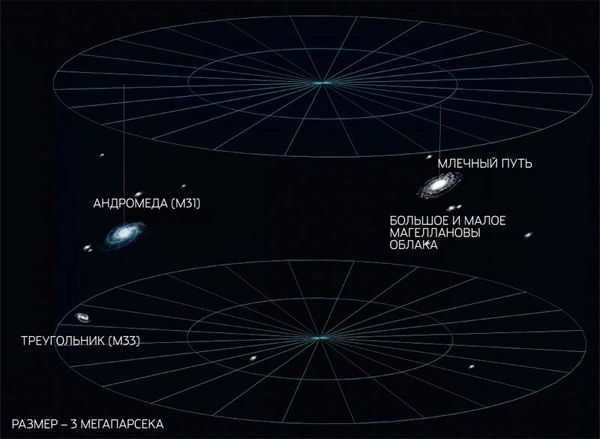
Irregular galaxies are classified as such due to their abundance of dust and gas and their active production of young stars. These galaxies are relatively scarce at moderate distances from the Milky Way, accounting for only 3% of the total. However, their prevalence dramatically increases among objects with a significant redshift, indicating that their formation occurred no later than 3 billion years after the Big Bang. This suggests that the initial generation of star systems consisted primarily of small, irregularly shaped galaxies, with larger disk-shaped and elliptical galaxies appearing later in cosmic history.
Galaxies appeared shortly after the formation of stars. It is thought that the initial celestial bodies emerged within 150 million years after the occurrence of the Big Bang. In January 2011, a group of astronomers who analyzed data from the Hubble Space Telescope announced a potential sighting of a galaxy whose light traveled through space approximately 480 million years after the Big Bang. In April, a separate team of researchers uncovered a galaxy that had probably already developed significantly when the early universe was around 200 million years old.
The Milky Way
The center of a normal spiral galaxy, containing 200-400 billion stars, is orbited by the Sun.
The approximate size of the galaxy is 28 kiloparsecs (which is slightly over 90 thousand light years). The solar intragalactic orbit has a radius of 8.5 kiloparsecs (causing our star to be positioned towards the outer edge of the galactic disk). It takes around 250 million years for the Sun to complete one revolution around the center of the Galaxy. The bulge of the Milky Way is elliptical and has a bar, which was recently discovered. Within the bar, there is a compact core filled with stars of various ages, ranging from a few million years to a billion years and older. Concealed behind dense dust clouds in the core is a relatively small black hole, with a mass of only 3.7 million times that of the Sun.
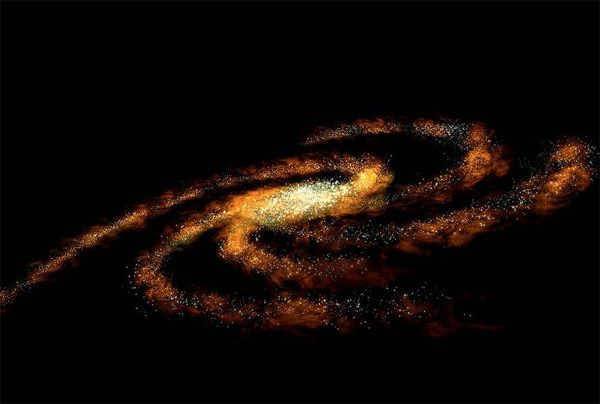
John Kormendy remarks that there are still numerous mysteries surrounding the formation of galaxies. One area that remains particularly elusive is the role played by black holes. These celestial objects can have masses ranging from tens of thousands to a staggering 6.6 billion times that of our Sun. The current record holder is a black hole located at the core of the M87 elliptical galaxy, which is situated approximately 53.5 million light years away. Typically, black holes found at the center of elliptical galaxies are surrounded by bulges composed of older stars. In contrast, spiral galaxies may lack bulges altogether or have flat structures known as pseudobulges. The mass of a black hole is typically three orders of magnitude smaller than the mass of the bulge, assuming one is present. This relationship has been consistently observed across a range of black hole masses, spanning from one million to one billion solar masses.
According to Prof. Kormendi, galactic black holes acquire mass through two different mechanisms. A black hole that is enveloped by a complete balge expands by absorbing gas that is drawn into the balge from the outer region of the galaxy. The influx of this gas intensifies significantly during galaxy mergers, which triggers the eruptions of quasars. Consequently, both the balges and the black holes develop simultaneously, providing an explanation for the correlation between their respective masses (although there may also be other mechanisms at play that are currently unknown).
Expanding galaxies
Attach the sleeves to the Milky Way
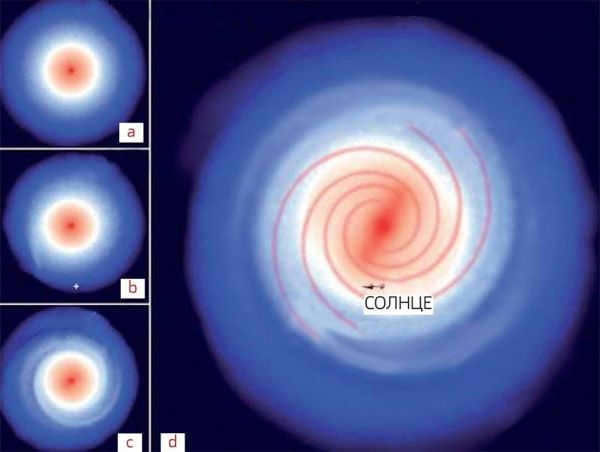
The diagram illustrates the evolutionary changes that have occurred at different time points – the initial state (a), after 0.9 billion years (b), 1.8 billion years (c), and 2.65 billion years (d). Based on theoretical calculations, it is suggested that the Milky Way’s bar and spiral arms might have originated from interactions with SagDEG, a dwarf galaxy that initially possessed a gravitational pull of 50-100 billion solar masses. SagDEG has traversed our Galaxy’s disk twice, losing a portion of its mass (both ordinary and dark matter) in the process, consequently causing disruptions in the structure of the Milky Way. Presently, SagDEG’s mass is estimated to be only tens of millions of solar masses, and it is predicted that its next collision, expected within the next 100 million years, will likely be its final encounter. Image: Popular Mechanics
Scientists from the University of Pittsburgh, the University of California at Irvine, and Florida Atlantic University have created a model to simulate the scenario of a collision between our Milky Way galaxy and its predecessor, the Sagittarius Dwarf Elliptical Galaxy (SagDEG). They examined two different collision scenarios, one involving a lighter SagDEG with a mass of 3×10^10 solar masses, and another involving a heavier SagDEG with a mass of 10^11 solar masses. The figure displayed below illustrates the results of 2.7 billion years of Milky Way evolution, comparing the outcomes of no interaction with SagDEG to the outcomes of interactions with both the light and heavy variants of SagDEG.
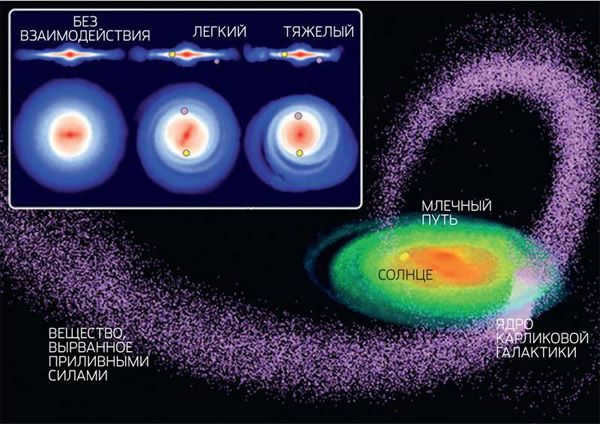
Generally speaking, the pattern is evident. Galaxies expand in two primary ways. Initially, they acquire fresh material for the formation of stars by attracting gas and dust particles from the surrounding space. For billions of years following the Big Bang, this mechanism functioned effectively due to the abundant stellar material available in space. Subsequently, as the supply diminished, the rate of star formation decreased. However, galaxies discovered a method to increase it by colliding and merging. Nevertheless, for this option to be realized, colliding galaxies must possess a sufficient amount of interstellar hydrogen. Merger does not benefit large elliptical galaxies, as their hydrogen reserves are nearly depleted, but it does apply to disk-shaped and irregular galaxies.
Headed for a Crash
Different-sized galaxies collide in different ways. When a large galaxy collides with a dwarf galaxy, it can either swallow it in one go or in multiple stages, while still maintaining its own structure. This process of galactic cannibalism can also trigger the formation of new stars. The dwarf galaxy completely collapses, leaving behind chains of stars and streams of cosmic gas, which have been observed in both our Galaxy and the nearby Andromeda. If the colliding galaxies are relatively evenly matched, even more intriguing phenomena can occur.
Anticipating the Arrival of the Super Telescope
The field of galactic astronomy has persevered for nearly ninety years. From humble beginnings, it has made significant advancements. However, numerous mysteries still remain unsolved. One such mystery is the exact process by which the first galaxies were formed, as well as the mechanisms behind the creation of disk-structured galaxies. “There is much anticipation surrounding the James Webb Infrared Orbiting Telescope, set to launch in 2018,” reveals Garth Illingworth. Unfortunately, the completion of this project is still uncertain due to financial limitations. Nevertheless, there is hope that it will come to fruition.”
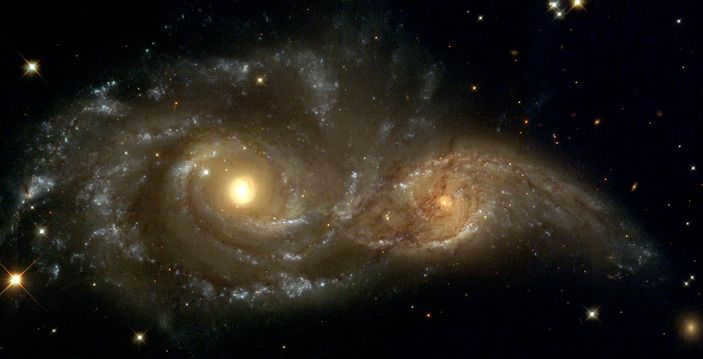
Figure 1. NGC 2207 and IC 2163 are spiral galaxies that are colliding with each other. The collision and merger of galaxies is a highly effective mechanism that can trigger the formation of new stars within the galaxies. This photograph was obtained from hubblesite.org
Over 20 years ago, the first scientific papers discussing the history of star formation in the Universe were published. Since then, hundreds of scientists from all over the world have been actively investigating the common patterns in the formation and evolution of galaxies over the past 10 billion years. It is now understood that the history of galaxies can be seen as a continuous process in which each new epoch logically follows the previous one, and nothing remains static. This article provides an overview of the current understanding in the field of astrophysics regarding the formation and evolution of galaxies.
Although much about galaxies remains unknown, one thing we can definitively state is that they undergo a process of evolution. Beginning as a cloud of dark matter, galaxies progress through several distinct stages, which may not necessarily occur in a specific order. These stages include an increase in density and cooling of the primordial gas, fragmentation of the gas into smaller clouds, the formation of the first stars, a period of active star formation, the emergence of a supermassive black hole at the galaxy’s center, the absorption of companion dwarf galaxies, the depletion of materials necessary for new star formation, and the morphological changes resulting from gradual evolution or collisions with other massive galaxies (Fig. 1).
The continuous evolution of galaxies has been occurring for billions of years: they acquire mass, alter in size and density, ignite new stars and witness the death of old ones, all of which impacts the observable hues of galaxies. Directly observing these transformations is impractical due to our limited lifespan. However, in recent years, using available observational data, astrophysicists have constructed a comprehensive model of galaxy evolution.
Galaxies are incredibly intricate structures. Elaborating on them in detail and characterizing each component individually is a challenging task, especially when there are millions or even billions of galaxies. Consequently, when discussing the overall properties of galaxies scattered across the Universe, scientists typically focus on a few key parameters: mass (measured in solar masses), size (in kiloparsecs), distance from us (often expressed in dimensionless redshift units), star formation rate, metallicity (the abundance of elements heavier than hydrogen and helium), the presence of dust, gas, and dark matter, and lastly, morphology (galaxies can be disk-shaped, spherical, lenticular, or irregular).
This is all just in theory. In actuality, our understanding of the Milky Way is either incomplete or its accuracy is extremely limited. If you were to ask an astrophysicist to select only three variables to study galaxies, they would likely choose mass, redshift, and star formation rate. These variables are sufficient for inputting the data of a known galaxy into a computer model and, from the initial cloud of dark matter that acts as a gravitational trap for hydrogen, generating a galaxy that closely resembles the one we observe after the specified billions of years (on the timescale of galaxies, of course – the computer can complete these operations in mere minutes).
In his 1996 paper “The Canada-France Redshift Survey: The Luminosity Density and Star Formation History of the Universe to z ~ 1,” astrophysicist Simon Lilly introduced the concept of studying the evolution of all galaxies as a unified process. This groundbreaking paper, spanning only four pages, had a significant impact on the field.
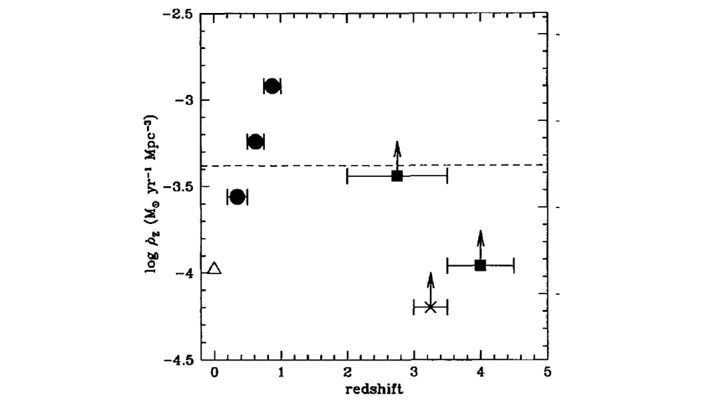
Figure 2. The diagram presented in Simon Lilly’s 1996 publication is commonly referred to as the “star formation history of the Universe”. The graph displays the star formation rate in relation to redshift. The horizontal axis represents time, with zero denoting the present moment and mark 4 symbolizing one billion years after the Big Bang.
Converting from the speed at which stars are formed to the amount of mass is not a difficult task. The concept is as follows. If, on average, 100 stars with a mass of the sun are created each year in a new galaxy, then by simply adding them up, we can determine that after a thousand years there will be one hundred thousand stars in the galaxy, with a total mass of 10^5 solar masses. For more complex systems, instead of adding them up, we use integration of the star formation rate over time. This allows us to always establish a relationship between the rate at which stars are formed and the total mass of the galaxy, and thus create a graph that shows the growth of the average stellar density in the Universe throughout the entire observation period. It is truly a remarkable and visually stunning piece of work, as it encapsulates the entire history of the universe in just a few points and curves!
To fully grasp the concept of the mass being measured, it is necessary to take a detour. According to current knowledge, there are two types of mass – dark matter, which consists of particles that have yet to be discovered and about which we can only speculate, and baryonic mass, which includes protons and neutrons. The composition and proportion of the different components of baryonic matter is a complex and separate topic, but in a 2012 study by Shull, Smith, and Danforth, the following ratio was provided, which, despite potential errors of up to 50%, is generally accepted within the scientific community:
- 57% of the baryonic mass is comprised of hot plasma and what is known as the warm-hot intergalactic medium. This matter is not gravitationally bound to galaxies and likely never was, and it is too hot to condense under self-gravity and initiate star formation.
- 5% represents an exceptionally rarefied substance that is gravitationally bound to galaxy clusters, but does not belong to any individual galaxy.
- 7% consists of gas (including molecular gas) that is gravitationally bound to certain galaxies. This gas serves as either the raw material for new stars or as matter that has already been expelled from their interiors due to a supernova explosion.
- 0.1% consists of dust. Although seemingly minuscule, this component of the universe is the most “harmful” as it obscures many details of galaxies and distorts their colors, posing challenges for astronomers in their observations (unless they specifically study dust). The impact of dust is universal – much like how visibility is impaired when driving on a dusty road, telescopes also “suffer”. To overcome the influence of dust, scientists are developing infrared telescopes, but we will delve into this topic further down the line.
- The mass of all supermassive black holes in galaxies accounts for only 0.01%.
- Stars make up 6% of the mass, which was precisely measured by Simon Lilly. Despite being a small percentage, it holds significant importance to us. After all, a galaxy is defined as a gravitationally bound system of stars!
By carefully examining the data, an observant individual will notice that there is a missing component when adding up all the percentages. However, we are not referring to planets, comets, and asteroids as their combined mass accounts for less than a thousandth of a percent of the total baryonic mass. This specific mass has been accurately measured through various space missions such as WMAP and Planck, with the intention of studying the uniformity of relic radiation. Relic radiation refers to thermal noise with a temperature of 2.725 K and has been found to possess a remarkable level of homogeneity. Essentially, it serves as a “fingerprint” of the Big Bang that is preserved throughout the Universe. The slight variations observed on the map are the result of the Syunyaev-Zel’dovich effect, wherein regions with a high concentration of baryons cause relic photons to slightly elevate above the overall background level.
The investigation of these irregularities, along with the constraints imposed by theories regarding the initial formation of matter right after the Big Bang, has provided scientists with an understanding of the total baryonic mass in the Universe. It appears that approximately 25% of the mass exists in a yet unidentified form (it is important to note that we are referring to baryonic mass and not dark matter). Referred to as the “Missing baryon mass” (see Missing baryon problem), this discovery seems to have been made recently through the use of X-ray telescopes. It consists of threads of hot plasma that span between pairs of galaxies, creating the appearance of galactic dumbbells (see the news article “Astrophysics during soccer: checking GR on galactic scales and missing baryon matter,” Elements, 02.07.2018, and the paper by A. de Graaff et al., 2017, “Missing baryons in the cosmic web revealed by the Sunyaev-Zel’dovich effect”).
Calculating the weight of galaxies
Now that we have determined the required mass, let’s attempt to calculate it. The primary source of information from galaxies is light. The process of converting light into mass is not a simple task and comes with its own complexities. Let’s start by examining the light emitted by a single star. The well-known Hertzsprung-Russell diagram allows us to identify a unique position on the “color-luminosity” graph for each star, which can also be interpreted as a “mass-temperature” relationship. Therefore, by determining the color of a star, we can accurately determine its mass, temperature, and often its age. In Figure 3, the horizontal axis represents the star’s color in unconventional units. B-V represents the difference in stellar magnitudes obtained from the B filter (which captures blue color) and the V filter (which captures green, yellow, and orange colors). A value of zero on this axis corresponds to a star that is equally bright in both filters (and, as seen from the graph, is a hundred times brighter than the Sun). Moving further along the positive region of the axis indicates a redder star. If astronomers come across a cluster of objects where B-V = 0, and the luminosity exceeds that of the Sun not by a hundred times as expected, but by a hundred thousand times, it would suggest a very young cluster consisting of a thousand stars, each of which is a hundred times brighter than the Sun.
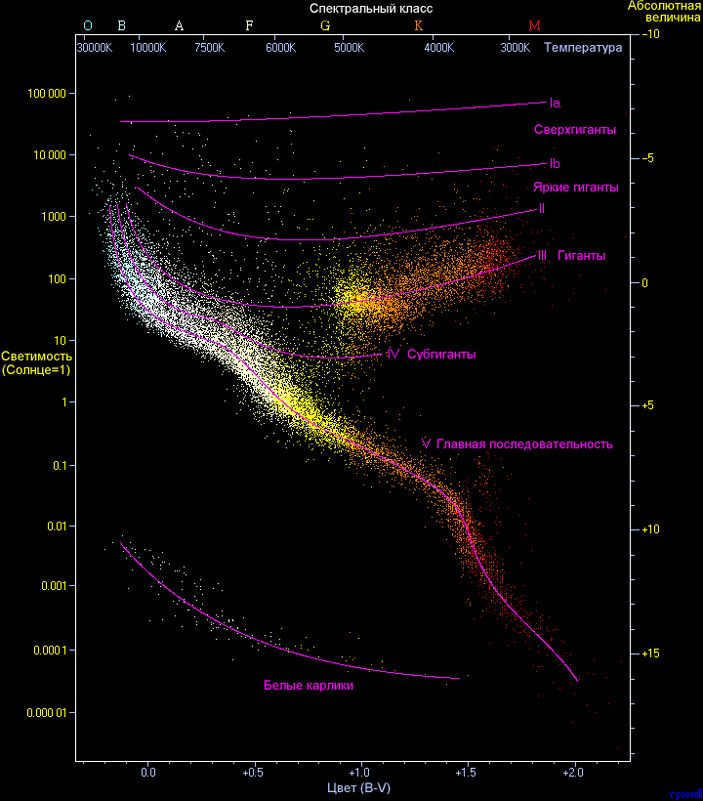
Figure 3. Hertzsprung-Russell diagram. Image from ru.wikipedia.org.
Galaxies present a more complex scenario. Each galaxy contains stars of varying masses, luminosities, and ages, ranging from newly formed to ancient ones on the verge of exploding as supernovas. Furthermore, many galaxies are not distinguishable through a telescope, causing stars of different colors – blue, yellow, red – to blend into a single entity. As a result, the combination of a blue and red star may produce a similar color to that of two yellow stars.
Additionally, within certain areas of the diagram, there exists degeneracy – where stars of the same color (e.g., B-V = 1.3) can vary greatly in brightness and mass. For instance, there may be a star that is 10 times dimmer than the Sun, as well as a star that is 100 times brighter and much more massive. This means that the redness of a galaxy may be attributed to an abundance of low-mass red dwarfs, or it could be due to the presence of short-lived massive stars (which are hundreds of times heavier than the Sun) in their final stage of life. In essence, relying solely on one color is not sufficient.
In order to eliminate the degeneracy caused by color, it is crucial to identify an alternative factor that signifies which stars emit a red hue. This alternative factor is none other than infrared radiation (which is, naturally, detected by infrared telescopes!). It originates from heated dust particles, which, although they still pose significant challenges to astronomers, also provide some assistance in this scenario: they serve as an indication of ongoing star formation within the galaxy.
Therefore, there exists a logical sequence. If there exists a substantial amount of hot dust within the galaxy, it implies that there is also an abundance of hydrogen present (as they commonly coexist) and some external force is actively raising the temperature of this dust. Hydrogen serves as the fundamental material for the creation of stars, which, when ignited, in turn, heat up the surrounding hydrogen-dust clouds. Newly formed stars encompass a wide range of masses and sizes, but it is the most massive and luminous ones that exhibit the greatest degree of dust heating. However, these massive stars possess the shortest lifespan, indicating that they have appeared relatively recently, and it is probable that new stars will continue to emerge within the galaxy – thus confirming the presence of ongoing star formation.
If the galaxy emits a feeble amount of infrared radiation, it signifies that there has been a dearth of star formation within it for an extended period of time, and all the red giants have long surpassed their prime, leaving only small-to-medium-sized red dwarfs responsible for the galaxy’s reddish hue.
The field of astrophysics has made significant progress in recent years thanks to the use of infrared telescopes. This technology has allowed scientists to explore a previously inaccessible portion of the electromagnetic spectrum, bridging the gap between the radio and optical ranges. By doing so, researchers have been able to differentiate between the light emitted by stars and the emission from active galactic nuclei, which can often resemble the light from a regular galaxy. This breakthrough has been instrumental in studying the history of star formation in the universe and understanding the behavior of black holes.
Therefore, the initial stage in determining the mass of a galaxy involves measuring its brightness in multiple filters, ideally including some that capture infrared light. Following this, we can create a spectral energy distribution (SED) – also known as a “poor man’s spectrum” because it only consists of a few data points that provide an approximate representation of the galaxy’s characteristics, rather than a continuous spectrum obtained from a lengthy observation of a single object.
The subsequent step is referred to as SED fitting, where the actual energy distribution of the galaxy is compared to a collection of synthetic spectra generated using computer models, our knowledge of galaxy evolution, and actual observations.
However, it must be acknowledged that every galaxy has a considerably more intricate history of star formation that cannot be accurately represented by a simple mathematical equation. The same can be said for other factors, such as the initial distribution of stars based on their mass (known as the initial mass function), the level of metallicity which impacts the rate at which a cold hydrogen cloud contracts to form a new star, and the presence of dust particles that absorb certain types of radiation and alter the visible color of the galaxy. These parameters are either determined by studying the galaxies in close proximity to our own, which may not accurately reflect what occurs at greater distances, or they are derived from theoretical models based on general concepts.
The SED fitting method, which is based on a collection of synthetic spectra from individual stars that compose a galaxy’s spectrum, is constantly being improved. Recently, a group of astrophysicists from England and New Zealand published an article in the journal Monthly Notices of the Royal Astronomical Society that revises the ages of certain galaxies and clusters by utilizing more accurate theoretical spectra. The article highlights the fact that current programs calculate star evolution as independent entities, disregarding the gravitational interactions and matter exchange that occur within gravitationally bound systems. When matter falls onto a star, it increases its mass and rejuvenates it, providing additional fuel for thermonuclear reactions. This research demonstrates the ongoing pursuit for new and more precise solutions to understanding star formation.
From the Birth of the Universe to the Peak of Cosmic Activity
Thanks to cutting-edge models and state-of-the-art telescopes, Simon Lilly and his team, including Piero Madau, Mark Dickinson, Simon Driver, Leonidas Moustakas, and other leading astrophysicists, have made significant advancements in the original graph over the past two decades. The graph, which initially consisted of only seven data points, has now been greatly enhanced and is depicted in Figure 4.
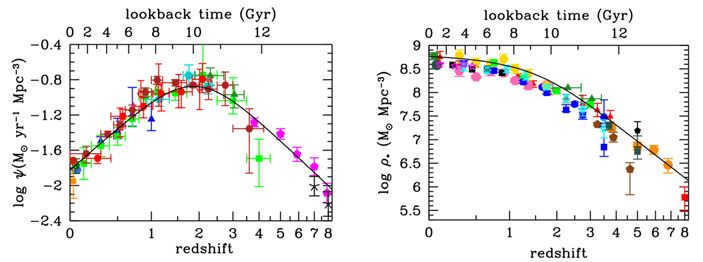
Figure 4. On the left: A contemporary representation of the fluctuations in the rate of star formation in the Universe (measured in decimal logarithms of the number of new stars per year in a cubic megaparsec). On the right: Alterations in the average density of stellar mass. The various colors correspond to distinct datasets gathered by different scientific teams. As we observe further into the past of the Universe (i.e., as the redshift on the graph increases), there is more limited data available, resulting in a wider variation in the data points. Graphs adapted from the research paper authored by P. Madau, M. Dickinson, 2014. Cosmic Star-Formation History
Multiple scientific groups have thoroughly analyzed these graphs, and they are currently undergoing further refinement, scrutiny, and interpretation. However, the key takeaways from these graphs can be summarized as follows:
1. The stellar mass of the Universe has consistently increased throughout the entire period of observation. Astrophysicists have not observed any galaxies losing their stellar mass over time, unlike the mass of gas or dust which can deplete over time.
2. There was a significant event in the history of the universe known as cosmic noon. During this period, star formation reached its peak, and galaxy masses rapidly grew. This cosmic noon occurred approximately 11 billion years ago and lasted for about two billion years. Based on our current understanding of the universe, it is unlikely that such a prolific star formation event will occur again due to the limited availability of free hydrogen.
What other possibilities exist for utilizing these graphs? For instance, we could categorize galaxies based on their color: blue, which indicates brighter, typically spiral galaxies with active star formation, and red, known as “red and dead,” which refers to old elliptical galaxies with minimal new star activity. In astronomy, color represents the variation in brightness between two filters. In 2003, Eric Bell and his colleagues conducted a study on the evolution of the masses of these two groups over time and obtained results that initially seem counterintuitive: the average density of galaxies experiencing regular new star formation remained constant, while the density of old elliptical galaxies, devoid of new stars, actually increased (E. F. Bell et al., 2003. The Optical and Near-Infrared Properties of Galaxies. I. Luminosity and Stellar Mass Functions).
Fig. 5 displays the most recent findings on galaxy evolution in these two groups. The galaxies are categorized into four groups based on their mass. The plots demonstrate a noticeable increase in the density of “dead” galaxies over time (from right to left), while the density of star-forming galaxies either stays constant or declines.
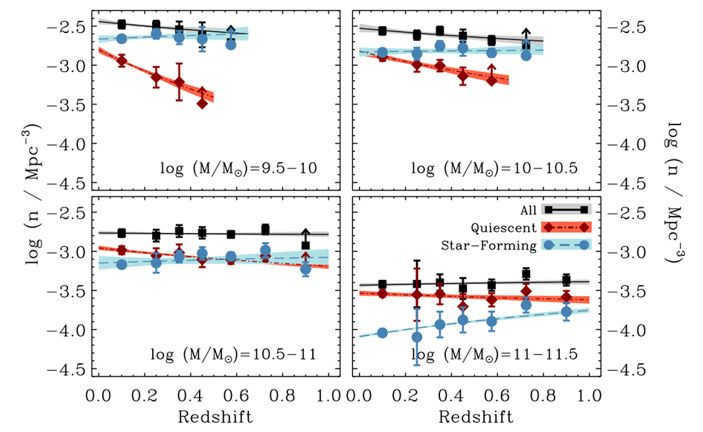
Since the publication of Lilly’s paper 22 years ago, numerous scientific groups have undertaken their own investigations to refine the parameters related to the increase in the average mass density of stars in the Universe. Several of these studies utilized wide sky surveys, such as the Sloan Digital Survey, which included hundreds of thousands of galaxies. However, the trade-off for this large quantity of data was a potential sacrifice in quality, as these surveys primarily observed the nearest or brightest galaxies. Alternatively, other studies relied on deep sky surveys, such as the renowned Hubble Ultra Deep Field, which only covers a small fraction of the total sky area. Nevertheless, within this limited field of view, the Hubble telescope managed to detect over ten thousand galaxies (Fig. 6).
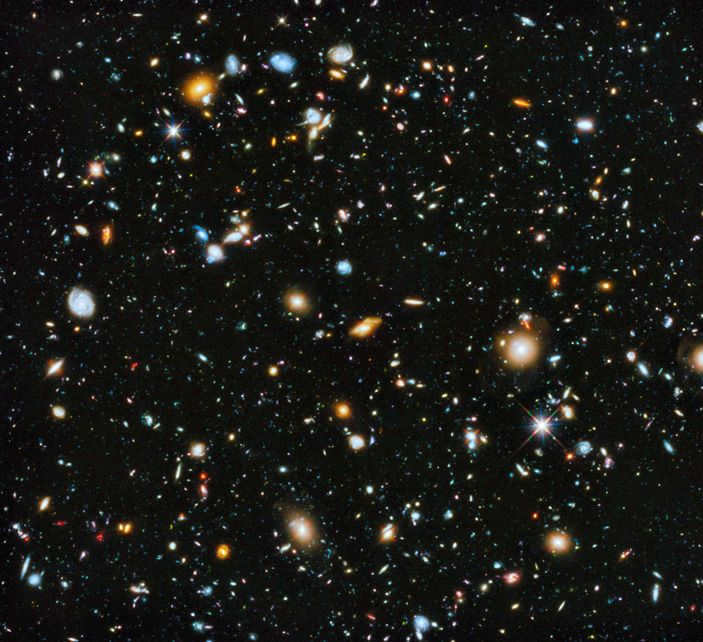
Figure 6. The Hubble Ultra Deep Field is an area of the sky measuring only 2.4 angular minutes in size (equivalent to about one-tenth of the size of the Moon) that captures a multitude of galaxies. This specific area was observed continuously for a period of 11 days, with the final image being a result of multiple images taken over several months due to technological limitations. Photo sourced from ru.wikipedia.org
There are only a few areas in the sky that have been extensively studied, and they represent a small portion of the total celestial sphere. However, it is these deep surveys that provide us with valuable information about galaxies in the early Universe. The data points in Figure 4, which depict stellar density at redshifts higher than z ~ 1, are derived from these surveys. The data on galaxies is then analyzed and extrapolated to the entire sky. However, this approach may introduce significant errors due to the uneven distribution of galaxies. There is no guarantee that a randomly selected area of the sky will have the average number of galaxies of all sizes at all redshifts. That’s why astrophysicists worldwide are eagerly anticipating the launch of new instruments such as James Webb, WFIRST, LSST, and making use of the Pan-STARRS telescope, which offers a wide field of view and high sensitivity, to further their research.
Throughout the ages, astronomers have gazed up at the heavens in wonder, gradually comprehending that our Sun is merely one of countless stars within the vast expanse of the Milky Way.
On a crisp evening, one can marvel at the streak of the Milky Way across the sky. For centuries, astronomers have contemplated it with amazement, gradually realizing that our Sun is just one of billions of stars in the Galaxy. As time passed, our tools and techniques advanced, and we came to understand that the Milky Way itself is merely one of billions of galaxies that constitute the Universe.
Thanks to the theory of relativity and the discovery of the speed of light, it has been revealed that when we observe space, we are essentially peering into the past. When we gaze upon an object situated one billion light years away, we are actually witnessing how it appeared a billion years ago. This phenomenon can be likened to a time machine, providing astronomers with the opportunity to investigate the development of galaxies.
The formation and evolution of galaxies is a matter of great fascination and continues to attract significant attention as it conceals numerous enigmas.
The prevailing scientific consensus holds that the entirety of matter in the cosmos came into existence roughly 13.8 billion years in the past during a remarkable phenomenon referred to as the Big Bang. In its nascent stages, all matter was confined within an incredibly minuscule, infinitely dense entity known as a singularity, characterized by an astronomical temperature. Suddenly, this singularity initiated a process of unprecedented expansion, serving as the catalyst for the birth of the universe.
Following a period of rapid expansion and subsequent cooling, the matter became distributed in a nearly uniform manner throughout the cosmos. Within a span of several billion years, regions of higher density within the universe commenced gravitational attraction towards one another, leading to their conglomeration and the formation of gaseous clouds and colossal conglomerates of matter.
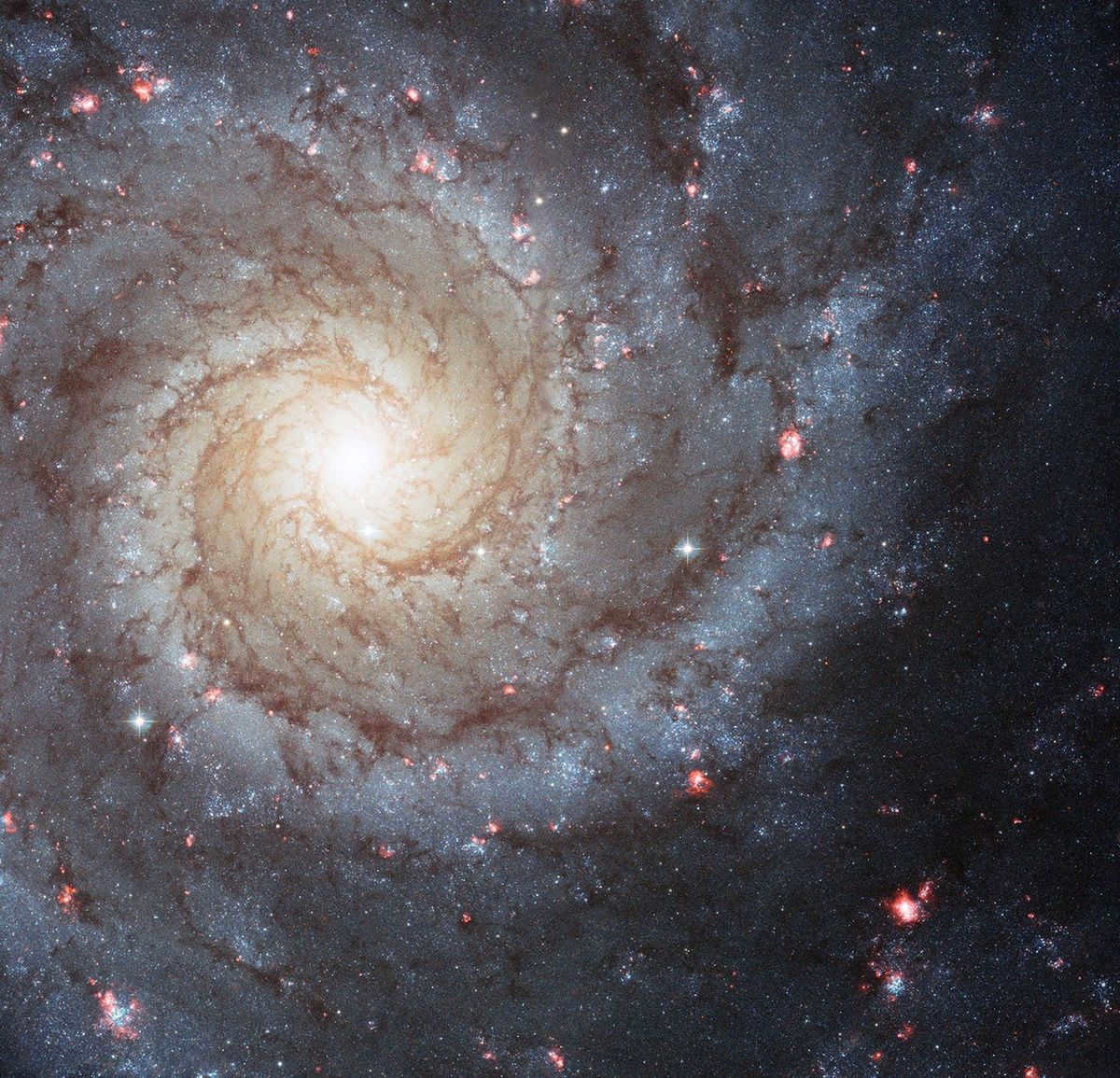
During the formation of galaxies, the clouds of hydrogen gas experienced gravitational collapse, leading to the birth of the initial stars. Among these early formations were small dwarf galaxies, while others developed into the iconic spiral structure resembling our own Milky Way.
Interstellar unions
Once created, these celestial bodies transformed into more extensive interstellar structures known as assemblages, agglomerations, and superclusters. As time passed, the galaxies were drawn towards one another due to the force of gravity and fused together. The result of these unions was contingent upon the mass of the colliding galaxies.
Smaller galaxies were engulfed by their larger counterparts, augmenting their mass. In this manner, the Milky Way recently devoured numerous dwarf galaxies, transforming them into streams of stars that orbit the core of the galaxy. However, galaxies of comparable size unite to form colossal elliptical galaxies.
Upon this occurrence, the slender spiral formations vanish. Elliptical galaxies represent some of the most vast stellar mergers. Another consequence of these unions is the further enlargement of the supermassive black holes located at their cores.
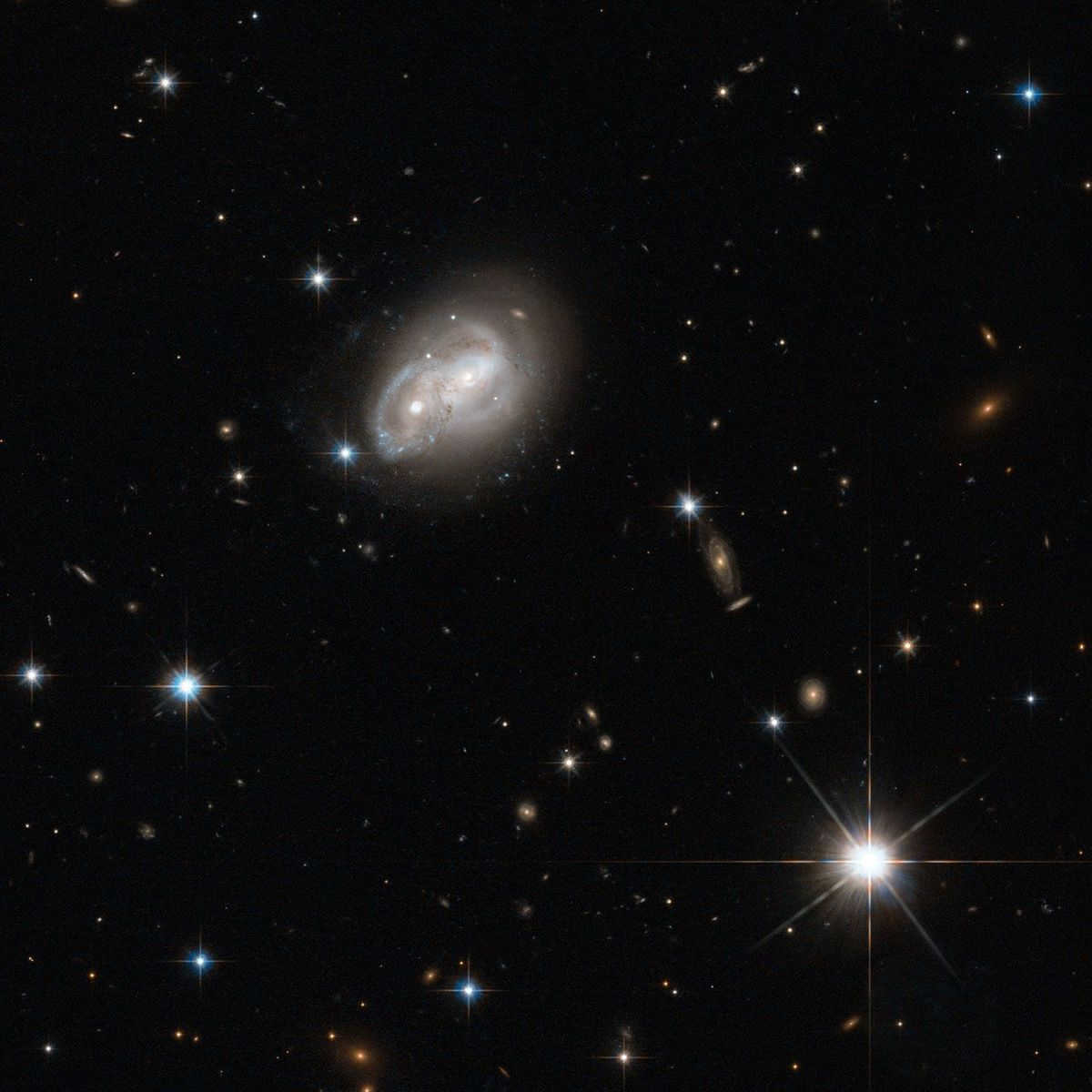
While not all combinations result in the creation of elliptical structures, they do all have a significant impact on the configuration of the combined galaxy.
During mergers, actual collisions between stellar systems are highly unlikely due to the immense distances between these celestial bodies. However, mergers can generate gravitational shockwaves that have the potential to initiate the formation of new stars. This is precisely what scientists anticipate will occur when the Milky Way collides with the Andromeda galaxy in approximately 4 billion years.
The end of galaxies
In due course, galaxies cease to produce stars when their reserves of cold gas and dust are exhausted. The process of star formation gradually decelerates over billions of years until it ultimately grinds to a halt. However, ongoing galactic mergers ensure that more and more stars, gas, and dust are deposited into aging galaxies, thereby prolonging their lifespan.
It is currently believed that our Galaxy, the Milky Way, possesses an abundance of hydrogen and star formation will persist until this supply is depleted. Stars like our Sun have a lifespan of approximately 10 billion years, while the smallest red dwarfs can endure for a few trillion years. With the presence of dwarf galaxies and the forthcoming merger with Andromeda, it is possible that the Milky Way could continue to exist for an even longer period of time.
Ultimately, all galaxies in the Universe become gravitationally bound and combine to form massive elliptical galaxies. Astronomers have come across these “fossils,” with Messier 49 serving as a notable instance of a supermassive elliptical galaxy.
